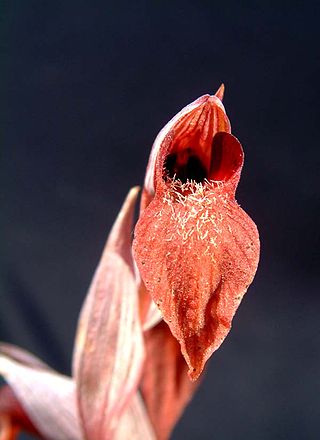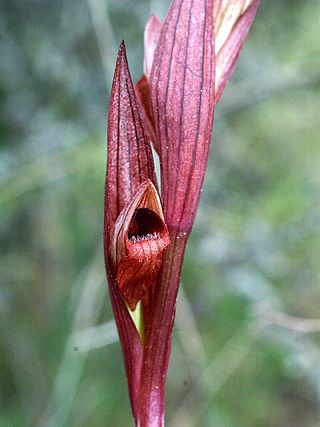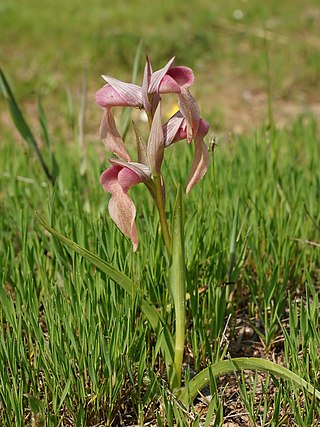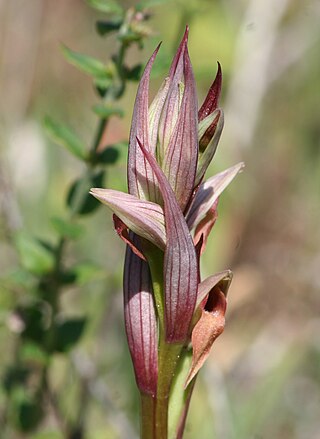
Dactylorhiza is a genus of flowering plants in the orchid family Orchidaceae. Its species are commonly called marsh orchids or spotted orchids. Dactylorhiza were previously classified under Orchis, which has two round tubers.
Tongue orchid or tongue-orchid is a common name for several plants and may refer to:

Saint Sabina was a saint and martyr of the early church. Her feast day is 29 August. She lived and suffered martyrdom at the beginning of the 2nd century in Rome.

Serapias is a genus of terrestrial orchids that can be found all over southern Europe to Asia Minor. The genus was named after Serapis, a syncretic Hellenistic-Egyptian god in Antiquity. Serapias have spurless flowers and usually go dormant during the winter seasons.

Serapia was a Roman saint, a slave and martyr, also called Seraphia or Seraphima of Syria.

Encyclia cordigera is a species of orchid.

Serapias bergonii is a species of orchids found from Italy to western and southern Turkey.

Serapias lingua, commonly known as tongue-orchid or the tongue Serapias, is a species of orchid native to the Mediterranean.

Serapias neglecta, the scarce tongue-orchid, is a species of orchid endemic to southern Europe.

Serapias orientalis is a species of orchids occurring from the east-central and eastern Mediterranean to the western Transcaucasus.

Serapias parviflora, the small-flowered tongue-orchid, is a species of orchid native to the Mediterranean Basin and the Atlantic coast of Europe.

Serapias vomeracea, common name long-lipped serapias or the plow-share serapias, is a species of orchid in the genus Serapias.

Coranarta cordigera, the small dark yellow underwing, is a moth of the family Noctuidae. The species was first described by Carl Peter Thunberg in 1788. It can be found in parts of Europe, mainly in the north. In central and southern Europe it is only found in mountainous areas. In the Alps for instance, it is found up to elevations of 2,200 meters.

The Bednja is a river in northern Croatia, a right tributary of the Drava. It is 133 kilometres (83 mi) long and its basin covers an area of 966 square kilometres (373 sq mi). The Bednja rises in the mountainous forested areas near Macelj in northern Croatia, west of Trakošćan, where it also forms a 0.2 km2 (0.077 sq mi) lake at 255 m.a.s.l. It flows towards the southeast until turning east near Bednja, meandering south at Novi Marof, returning to its eastward course shortly thereafter, and then turning northeast toward Ludbreg. It flows into the Drava River north of Mali Bukovec, at 46.303333°N 16.756389°E.
Parapithecidae is an extinct family of primates which lived in the Eocene and Oligocene periods in Egypt. Eocene fossils from Myanmar are sometimes included in the family in addition. They showed certain similarities in dentition to Condylarthra, but had short faces and jaws shaped like those of tarsiers. They are part of the superfamily Parapithecoidea, perhaps equally related to Ceboidea and Cercopithecoidea plus Hominoidea - but the placement of Parapithecoidea is substantially uncertain.

Orthetrum serapia, the green skimmer, is a freshwater dragonfly in the family Libellulidae. The serapia species is present in Australia, the Philippines, Fiji, Papua New Guinea and Solomon Islands. It inhabits a wide range of still and sluggish waters, often shallow. In Australia it ranges from the top end of the Northern Territory to about Mackay in central Queensland.
John Traherne Moggridge was a British botanist, entomologist, and arachnologist. A Fellow of the Linnean Society of London, he was known as a keen naturalist with great observational skills, as well as his paintings and illustrations. He wrote several articles on the fertilisation of plants, and his paintings of plants of southern France appeared in Contributions to the Flora of Mentone. His two volume study, Harvesting Ants and Trap-door Spiders, among other observations, confirmed that harvester ants are present in Europe, and was one of the first comprehensive treatments of the burrowing behaviour of trapdoor spiders. He was a correspondent of Charles Darwin, who cited his work in his books Fertilisation of Orchids and The Descent of Man, and Selection in Relation to Sex.
Proteopithecidae is an extinct family of primates which lived in the Priabonian and probably early Oligocene periods. Fossils that have been found are in the Jebel Qatrani Formation in Egypt. Currently two genera are recognised, each with a single species, those being Proteopithecus sylviae and Serapia eocaena.

Neis is a genus of nudan ctenophores. It is a monotypic genus containing the single species Neis cordigera. It occurs only near Australia. As all beroids, it is a free-swimmer that form part of the plankton.
Seraphia, Serafia, or Serapia may refer to:















